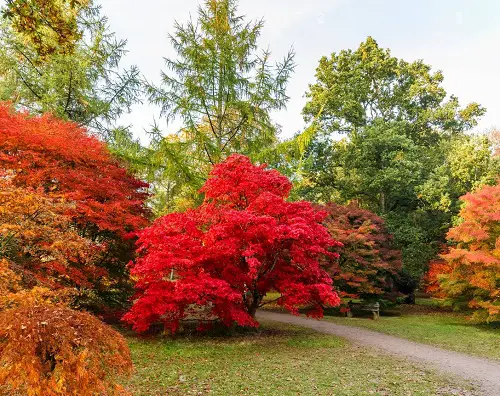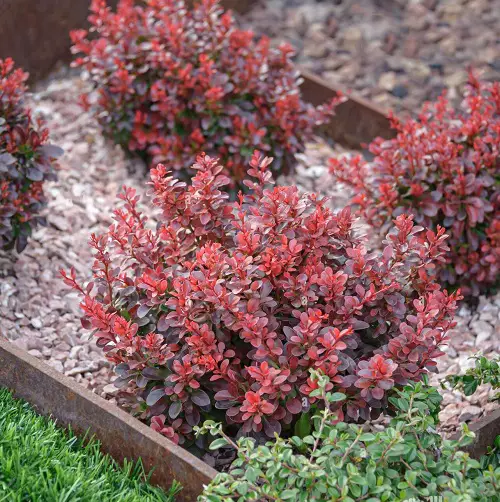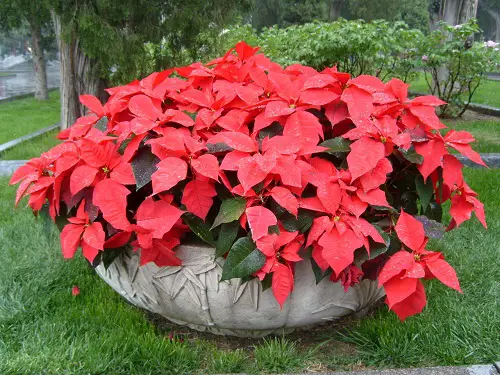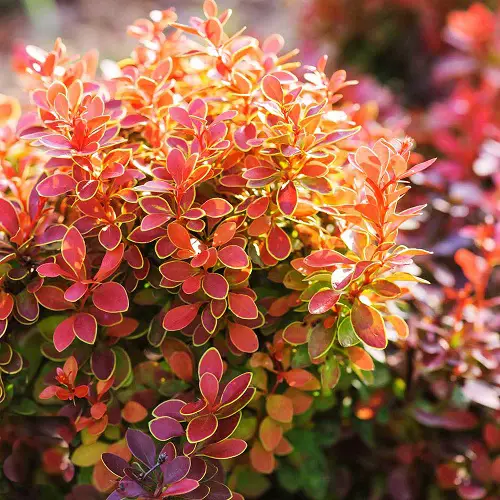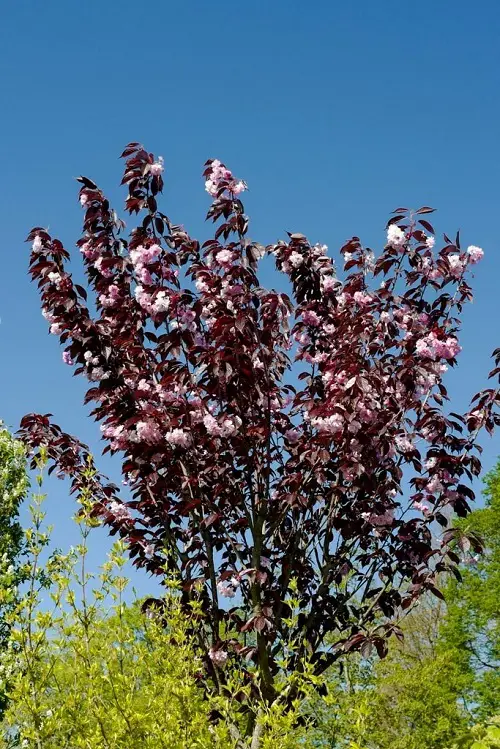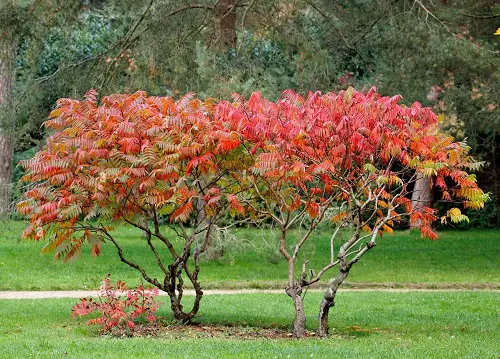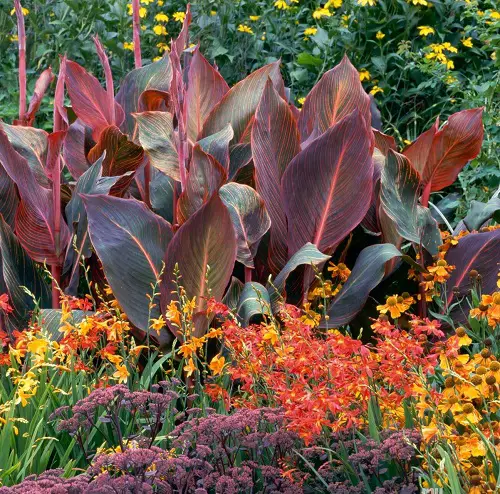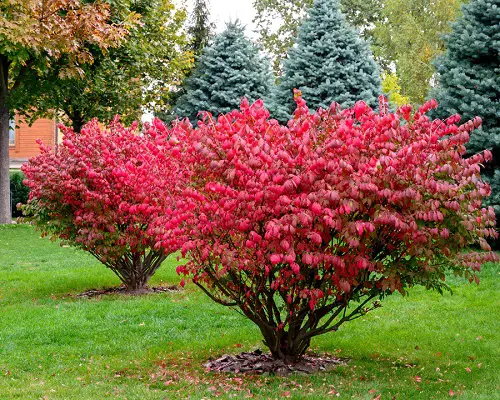Do you want to add some fiery flair to your outdoor space? These Red Leaf Plant varieties will help you do just that!
There are plenty of options for adding a pop of red to your garden, from bold blooms to striking foliage. Here are some of the Red Leaf Plant varieties.
Here are the Best Red Ferns You Can Grow
Best Red Leaf Plant Varieties
1. Red-Leaf Japanese Maple
Botanical Name: Acer palmatum ‘Atropurpureum’
USDA Zones: 5-9
The Red-Leaf Japanese Maple is a showstopper among Plants with Red Leaves. This tree is perfect for adding color and interest to your landscape. The compact size makes it ideal for small gardens and containers.
2. Red Fountain Grass
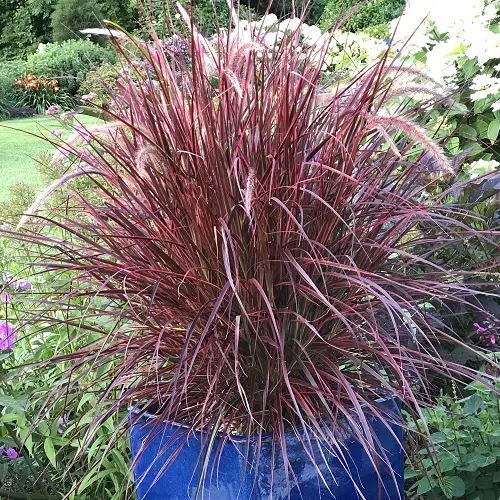
Botanical Name: Pennisetum setaceum ‘Rubrum’
USDA Zones: 9-10
The Red Fountain Grass is perfect for adding texture and movement to your garden, with burgundy-red foliage that sways in the breeze.
3. Crimson Pygmy Barberry
Botanical Name: Berberis thunbergii ‘Crimson Pygmy’
USDA Zones: 4-8
Crimson Pygmy Barberry is a compact shrub that shows off deep red leaves and spiky texture.
4. Burgundy Loropetalum
Botanical Name: Loropetalum chinense rubrum ‘Burgundy’
USDA Zones: 7-9
Burgundy Loropetalum is an excellent choice. This small shrub has a cascading form and gorgeous, deep burgundy leaves that add a touch of drama to any landscape.
Get the Best Loropetalum Pruning Guide
5. Poinsettia
Botanical Name: Euphorbia pulcherrima
USDA Zones: 8-11
Poinsettia can even be grown in partial to full sun and needs very little maintenance. It is an evergreen shrub that can reach heights of up to 7-8 feet tall.
6. Canadian Redbud Tree
Botanical Name: Cercis canadensis ˈForest Pansyˈ
USDA Zones: 4-9
If you want a tree with somewhat red or pink foliage, then the Canadian redbud tree, ˈForest Pansyˈ, is a good option. It features heart-shaped leaves that start off bright purple in the spring and deepen to a rich maroon throughout the summer.
7. Copperhead Copper Plants
Botanical Name: Acalypha wilkesiana ‘Copperhead’
USDA Zones: 9-11
The Copperhead Copper Plant features striking leaves in shades of bronze, copper, and maroon. These rich colors will make your garden stand out.
8. Coleus
Botanical Name: Coleus ‘Main Street Beale’
USDA Zones: 10-11
This Red Leaf Plant features a unique mix of rich maroon, deep green, and hints of copper. The leaves also have a velvety texture that you won’t be able to resist touching.
9. Diablo Ninebark
Botanical Name: Physocarpus opulifolius Little Angel
USDA Zones: 3-7
This shrub with dark purple leaves resembles a glass of red wine. The distinct texture of leaves make them more appealing.
10. Gagnepain’s Barberry
Botanical Name: Berberis thunbergii f. atropurpurea ‘Admiration’
USDA Zones: 5-9
Gagnepain’s Barberry has slender, deep green leaves with a glossy finish and sharp thorns along the stems. It is a standout among plants with red leaves, transitioning into shades of red and orange in the fall.
11. Japanese Clove Cherry
Botanical Name: Prunus serrulata ˈRoyal Burgundyˈ
USDA Zones: 5-7
If you’re seeking red foliage plants, the Japanese clove cherry is a striking tree option. Its glossy, deep burgundy leaves make it a standout in any garden.
12. Red Robin Photinia
Botanical Name: Photinia fraseri ˈRed Robinˈ
USDA Zones: 3-10
Photinia ‘Red Robin’ is a shrub with deep green leaves that turn a bright red in the spring. This Red Foliage Plant can add some dramatic vibe to their garden.
13. Brazilian Red Hots Alternanthera

Botanical Name: Alternanthera ‘Brazilian Red Hots’
USDA Zones: 9-11
The Raspberry Rum Alternanthera showcases red-colored leaves. This easy-to-grow plant is ideal for beginners.
14. Red Basil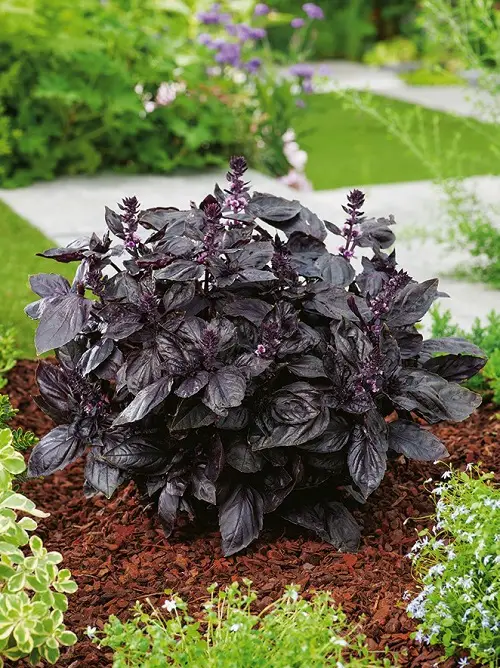
Botanical Name: Ocimum basilicum
USDA Zones: 10-11
Red Basil is not just visually appealing with its dark red leaves, but it also adds a unique flavor to your dishes. It’s easy to grow, making it a great choice for herb gardens or small containers.
15. Red Majestic Contorted Filbert
Botanical Name: Corylus avellana ‘Red Majestic’
USDA Zones: 4-8
The Red Dragon Contorted Filbert exhibits twisted, contorted branches and deep red leaves.
16. Red Leafed Mukdenia
Botanical Name: Mukdenia rossii ‘Karasuba’
USDA Zones: 4-9
The red-leafed Mukdenia is a great ground cover choice, and the lovely red foliage resembles tiny maple leaves.
17. Coral Bells
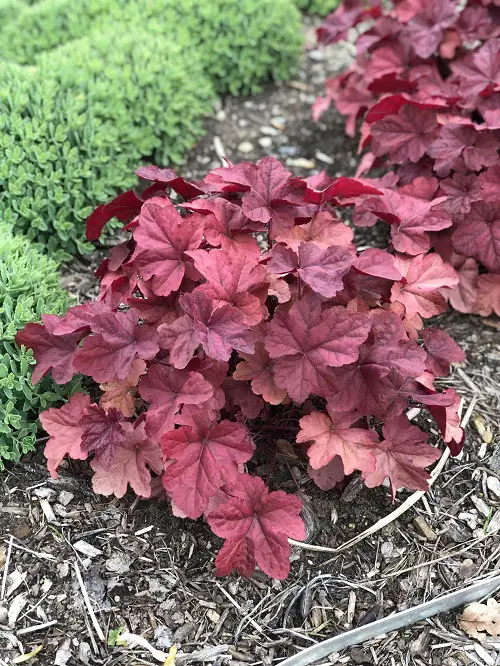
Botanical Name: Heuchera ‘lava lamp’
USDA Zones: 3-9
Red-leafed Coral Bells feature stunning red leaves that look great as a backdrop to smaller plants. Also, it produces pretty pink flowers in the summer.
18. Red Leaf Sumac
Botanical Name: Rhus glabra ‘Laciniata’
USDA Zones: 4-9
Rhus glabra ‘Laciniata,’ or Red Leaf Sumac, is a deciduous shrub that can grow up to 10-15 feet tall and wide. It has deeply cut, green leaves that turn red in the fall, adding a splash of color to your garden.
19. Red Leaf Canna
Botanical Name: Canna ‘Tropicanna’
USDA Zones: 6-11
Canna ‘Tropicanna’ shows off striking colors of green, orange, pink, and red. Also, the plant produces large flowers in shades of bright red and yellow.
Look at some More Charming Trees with Red Leaves
20. Spiraea Double Play Big Bang
Botanical Name: Spirea japonica ‘
USDA Zones: 4-9
The Spiraea Double Play Big Bang is sure to brighten up any garden or landscape. In spring, the leaves emerge bright red, transition to yellow, and eventually mature to green.
21. Red Twig Dogwood
Botanical Name: Cornus sericea
USDA Zones: 2-7
The Red-twig Dogwood is a deciduous shrub that can grow up to 9 feet tall and wide. It produces green leaves that turn red in the fall, but the focal point of the plant is the bright red twigs, which add winter interest to the garden.
22. Red Leaf Rose
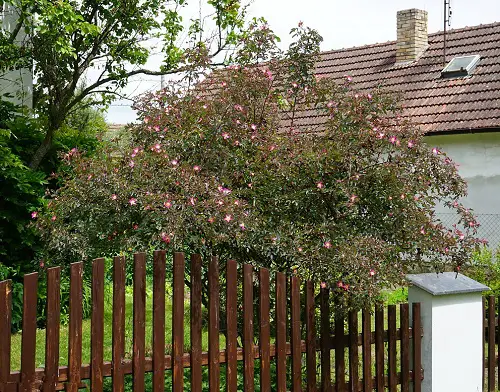
Botanical Name: Rosa glauca
USDA Zones: 2-8
The Red Leaf Rose is a deciduous shrub that can grow up to 6 feet tall and wide. It features green-blue leaves that turn deep purple-red in fall.
23. Weigela
Botanical Name: Weigela
USDA Zones: 4-8
Weigela is a deciduous shrub that can grow up to 10 feet tall and wide. It has dark green leaves and produces tubular, bell-shaped flowers in shades of pink, red, and white in late spring or early summer.
24. Red-leaf Mangave
Botanical Name: Mangave ‘Bloodspot’
USDA Zones: 9-11
The Red-leaf Mangave, or Mangave ‘Bloodspot,’ is a succulent plant that is a hybrid between Agave and Manfreda. It has striking red spots on the leaves that contrast with the bluish-green background.
25. Burning Bush
Botanical Name: Euonymus alatus
USDA Zones: 4-8
Also known as the Burning Bush, it is a deciduous shrub that grows up to 15 feet tall and wide. The green leaves turn in to a brilliant red in the fall.
26. Red Leaf Aralia
Botanical Name: Fatsia japonica ‘Spider’s Web’
USDA Zones: 7-10
Fatsia japonica ‘Spider’s Web,’ or Red-leaf Aralia, is a shrub that can grow up to 4-5 feet tall and wide. This red foliage plant has large, glossy green leaves with white speckles, making them look like spider webs.
27. Red Leaf Banana
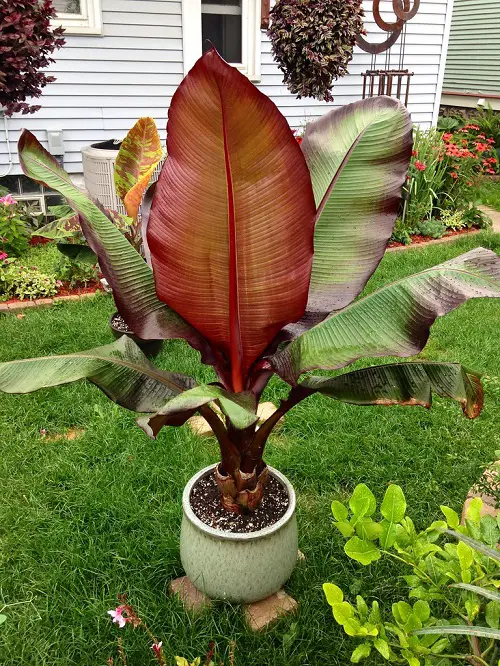
Botanical Name: Musa acuminata ‘Red Dacca’
USDA Zones: 8-11
Red Leaf Bananas produce large, bright red leaves and yellow-green flowers that turn into edible fruits. They prefer full sun and moist, well-drained soil.
28. Red Agloenema

Botanical Name: Aglaonema ‘Siam Aurora’
USDA Zones: 8-11
The Red Agloenema is a low-maintenance evergreen shrub that can be grown in full sun or partial shade. The foliage shows a combination of red and maroon. In spring, it produces small white flowers.
29. Cranberry Hibiscus
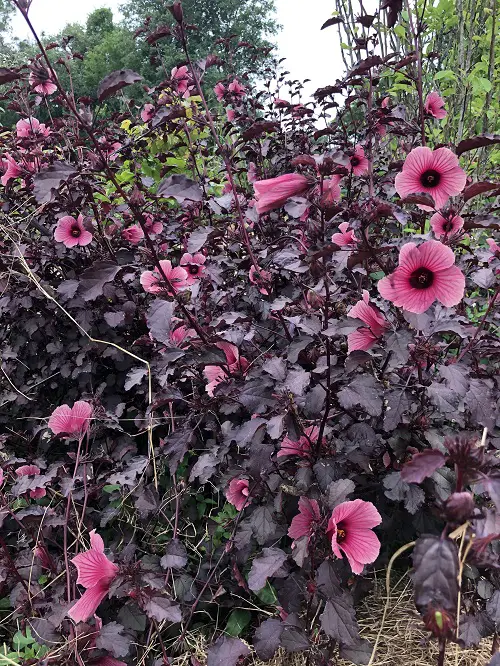
Botanical Name: Hibiscus acetosella
USDA Zones: 8-11
It features large, deep green leaves that are dark burgundy-red to black in color. The flowers are a deep pink-red and bloom in summer, with a second flush of blooms in the fall.
30. Red Euphorbia
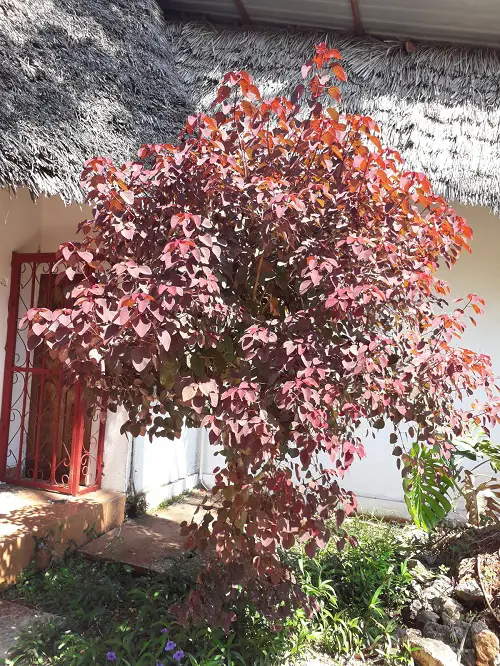
Botanical Name: Euphorbia cotinifolia
USDA Zones: 9-11
It is an excellent plant for container gardening and a good choice for adding texture and color to the landscape. The foliage is dark green with a reddish-purple tint. The flowers are small and yellow, with red bracts surrounding them.


